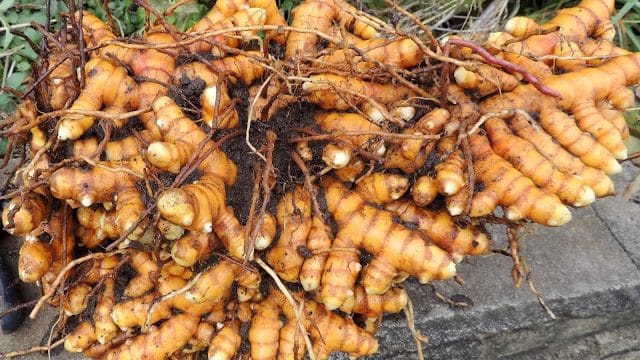I have given away more that 10,000 edible cuttings from my garden over the past couple of years, and the garden still looks amazingly abundant. This is the beauty of edible perennials – they just keep giving, and the haircut keeps them looking good too.
Edible perennials are at the heart of a successful permaculture garden – and are definitely at the core of my garden. These plants live for many years, are abundant, and bring diversity and resilience to the garden.
I am in awe of how much they can produce in so many ways. They perform many functions in the system and dramatically increase the harvestable yield. Not only do perennials provide an ongoing supply of food, fibre and medicine for the gardener, they also provide structure to the garden, mulch, in-garden windbreaks or shade, habitat for beneficial insects, hides for birds and frogs, pollen for bees, and organic matter for the soil.
Perennials are so easy to grow and harvest – great for the novice gardener. Well-chosen perennials need little maintenance to be healthy and will come back year after year. They can withstand difficult conditions and are great for challenging corners of the garden. Their root systems access water and nutrients deep in the soil, making them typically more hardy and self-reliant than annuals.
There are thousands of edible perennials to choose from. Here are a few easy ones to get you started, then just keep on adding diversity…and enjoy the harvest!
TURMERIC (Curcuma longa)
 |
| Turmeric, of the ginger family, has been used in India for over 2500 years. Well known as the yellow colour in curries, it is actually a medicinal powerhouse with a great health benefits. Eat some every day. Fresh is best – in juices, curries, grated in salad, or in yellow rice. Plant some, and nine months later dig for the abundant rhizomes. One of my plants yielded 5 kg last year! |
ALOE VERA (Aloe vera barbadensis)
 |
Aloe vera, a perennial succulent, another with incredible medicinal benefits, has been used therapeutically for over 5000 years. It cools burns and sunburn, soothes bites and rough skin. Add the clear pulp to smoothies, or finely slice it into salads to improve digestion and to detox. It’s drought tolerant and pest-resistant, but can get sunburnt. I keep it close to the kitchen for burn emergencies. |
YACON (Smallanthus sonchifolius)
 |
|
Yacon, or Peruvian ground apple, is a fascinating and bountiful addition to a perennial food garden. It grows to two metres and does well even in poor soils. The ground heaves with the abundance of tubers that form underground in autumn. In the subtropics, the plant dies back in winter, but re-emerges in late Spring when the temperature and moisture rises again. Eat the crunchy sweet tubers grated in salads, juiced, or cooked. Eat the leaves too. |
QUEENSLAND ARROWROOT (Canna edulis)
 |
|
Arrowroot is an ancient Inca food and an extremely useful perennial. It is prolific and easy to grow and the edible rhizomes and young shoots provide year-round food. The lush leaves are great as mulch and build up soil organic matter. Also the fast growing leaves provide an in-garden windbreak or summer shade if placed well. I eat the purple-skinned rhizomes before the shoots develop into leaves – in soup or curry. |
COMFREY (Symphytum officinale)
 |
Comfrey is indispensable in a permaculture garden – an excellent soil conditioner, dynamic accumulator, mulch, compost activator, liquid manure ingredient, nutrient trap, weed barrier, animal and bee forage. A great topical healing herb too. |
BRAZILIAN SPINACH (Alternanthera sissoo)
 |
I call this hardy edible groundcover my ‘happy spinach’ because it looks fabulous, has a great texture and guarantees I’ll have fresh greens in my garden all year round. Brazilian Spinach is so easy to grow and even after a hot day, it still looks glossy and healthy. Use it raw or cooked. As a border plant, it requires almost no attention and has few pests. |
TULSI, HOLY BASIL (Ocimum sanctum)
 |
|
Tulsi, a sacred healing herb from India, helps reduce stress, strengthen immune systems, promote longevity, increase endurance, fight infections, relieve congestion and headaches, and improve digestion. It’s also a rich source of vitamins and minerals. In a permaculture garden its constant flowering attracts pollinators and other beneficial insects, and it provides protection for small birds that help with pest management. A favourite garden tea of mine is a blend of tulsi leaves, mint, lemon myrtle, lime, turmeric, ginger with a dash of honey. |
SOCIETY GARLIC (Tulbaghia violacea)
 |
Society garlic provides greens and flavour all year round and is very drought hardy. It makes an excellent edge – dense clumps of upright leaves can hold back mulch and help to keep weeds out. Both the leaves and mauve flowers are edible, and make a great addition to salads, dressings, omelettes, stir-fries, soups and sauces. |




Morag I cannot believe I missed this post when it was first published. This is really appropriate for my allotment. It's helpful to know how much of these plants we can use too.
I don't have any of these definitely on my list to Aquire! I also missed this post I'm not far from you so these should go great where I am also 🙂 have recently started my first permaculture garden and working on the concept with my other gardens! So far so good our soil isn't the best so I think it's helping with that issue